Genre: Run-‘N-Gun Developer: Treasure Publisher: Sega Players: 1 Released:10/25/05
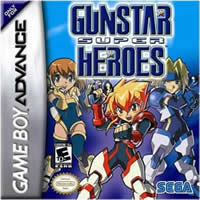 Back in 1993 Treasure came up with one of the most ingenious and fun shooters to ever grace a console, Gunstar Heroes. Released on the Genesis, the game soon became a classic and just showed how strong the shooter genre was at the time. Its unique level design, with its insanely fluid gameplay and action, wowed tons of gamers worldwide. Such a game had never been presented so well or played so good. It came out at a time when games were very limited in regard to what they could do – outside of the likes of adventure games and RPGs – which just made the game even more special. In a market that was generally dominated by platformers and fighting games, the game is undoubtedly Treasure’s most well known and recognizable achievement.
Back in 1993 Treasure came up with one of the most ingenious and fun shooters to ever grace a console, Gunstar Heroes. Released on the Genesis, the game soon became a classic and just showed how strong the shooter genre was at the time. Its unique level design, with its insanely fluid gameplay and action, wowed tons of gamers worldwide. Such a game had never been presented so well or played so good. It came out at a time when games were very limited in regard to what they could do – outside of the likes of adventure games and RPGs – which just made the game even more special. In a market that was generally dominated by platformers and fighting games, the game is undoubtedly Treasure’s most well known and recognizable achievement.
Seven Force
Although to some bringing out a remake of sorts to such a critically acclaimed game makes sense, to others who know Gunstar‘s developer, Treasure, it would seem very odd. Treasure prides itself with coming out with genuine games every chance they get, and they have a strong belief that games shouldn’t get sequels and remakes after remake. So for a developer such as Treasure to bring out a sequel/remake of one of their games is very odd. Gunstar Super Heroes starts off with a brief homage to the original game. A short series of stills are shown upon booting up the game, with text explaining the glaringly obvious story of the last game. It’s a handy reference for newcomers to Treasure’s games who haven’t played the original Gunstar, and a nice nostalgic reference for veteran players of the game. The original title screen, now in a slightly more flashy style, also helps enhance the nostalgic feeling that veterans will get.
The first of a rather numerous amount of changes to appear is the added difficulty options that are now available to play. The original game didn’t have any other difficulties, other than the default setting. This is a lovely addition on Treasure’s behalf and really opens up the game to a larger audience. Those who just want a game that they can breeze through without much trouble will obviously choose easy. And it really is easy. And when I say easy, what I really mean is unbelievably easy. Note to veteran players, do not start on easy, if you enjoyed Gunstar Heroesfor it’s decent challenge then you owe it to yourself to play on either normal, or hard. Easy just dumbs down the experience. The second, other obvious change is the manual selection of two totally different characters going by the tag or red or blue. There really are no distinct difference between the two characters apart from the fact that they both look completely different to each other. It’s a nice touch, as the original characters didn’t really have many distinct features about them. Plus the anime style in which the characters are presented in works well during the conversation exchanges and in-game play.
Gameplay is pretty much identical to the original Gunstar game, which isn’t a bad thing, as the gameplay is without a doubt the game’s strongest factor. All the basic play mechanics are all there, except with a few minor and significant improvements. For one, both free fire mode and fixed fire mode have been melded onto the one control scheme. For those who haven’t played the original, free fire allows you to fire while moving, while fixed fire sets you on a fixed axis from which you can fire more accurately. The option to use both simultaneously wasn’t included in the original game, but Treasure managed to implement both styles of play onto the same control scheme. Throw a handful of extra control layouts into the fray and you have a more flexible game. Additional firing modes have also been added, such as the addition of three weapon slots instead of the original two, which really gives the player more choice when it comes to combining different power ups to create new types of fire. That was one of the simple joys of the first game; you could pick up two different power ups and combine them to create a different mode of fire, so the added weapon slot really opens the game up more when it comes to experimenting with power up combos. Allowing for more devastating weapon power and longer range of fire. Treasures shooters have always been about their unique system and interface and Super Heroes really does emulate the system of the original very well on a handheld system.
There are however two rather glaringly disappointing additions/sacrifices Treasure have made when developing Gunstar Super Heroes. One being the changes to weapon fire. The original game allowed you to kind of manipulate certain types of fire, your aiming was based on a 360 degree angle on certain modes of fire but Treasure ditched the system and decided to go with an eight way axis when it comes to firing. This doesn’t kill the game but it does feel kind of disappointing, especially when the Genesis version (Which also used a D-Pad) managed to provide a more flexible aiming system. The other complaint is the recreation of some of the levels. Some of the additions to the original four stages are brilliant. Take the intro of the attack plane level, for instance. It starts off with a some neat top down shooting gameplay, followed by an upwards assault on the side of the airborne ship while balancing on top of your own ship. It’s a really nice change of pace from the original where you had to scale a repetitive piece of scaffolding to reach the top. But some of the changes made to a couple of the levels halfway through the first and third stages are rather disappointing, such as the shortening of the mine level, and the rotating puzzle after beating the first sub boss of the first stage. The changes made to the structure of some of the stages are a mix of good or bad, and could disappoint some of the more serious Gunstarveterans. The boss battles are still as fun as ever. Each boss really requires their own strategy, and the way that the game implements their weaknesses and strengths is really well done. Those who have a strong memory of fighting the games most versatile boss, Seven Force, will be glad to hear that he’s been given an upgrade and is even harder on the later difficulties.
Guns Blazing
This has to be possibly the best looking title on the Game Boy Advance to date. I was really impressed by the way everything was presented; it looks awesome for a title running on a supposedly technically inferior handheld system. This looks like something you’d see in more recent games, and the screens featured don’t really do the game justice. Everything just looks so well-drawn and sharp. The animation is astounding and the variety in design and color also bode well for Treasure’s latest game. The anime style really suits the game, as did the same style that the original used, except it’s been expanded upon. Improved boss and character designs also show that the GBA still has life left in it.
Retro junkies are really going to get a buzz off the game’s soundtrack. All the familiar tunes are there, such as the clear stage jingle, and all the previous game’s stage music. As soon as you hear the tunes you’ll think of the old game, and what made it so memorable in the first place. Mix this with some decent audio samples and you have a great sounding handheld title.
Super Hero?
Gunstar Super Heroes stands up well as a remake and also as a sequel hybrid to the original. A lot of the little updates are welcome, but the dumbing down of some of the games latter sections and the more focused eight-way firing path may disappoint the older gamers who enjoyed the original for everything it had. New players looking for something a tad different or just a old school shooter will do well to pick up Gunstar Super Heroes. It’s a lovely nostalgic trip to the past, but some of the small things that were removed may leave some veteran players a tad disappointed that they didn’t keep all the old stuff in.

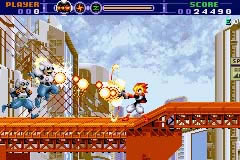
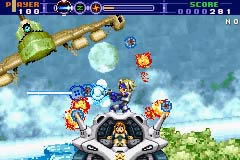
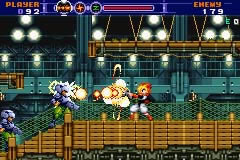
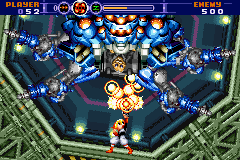

Recent Comments